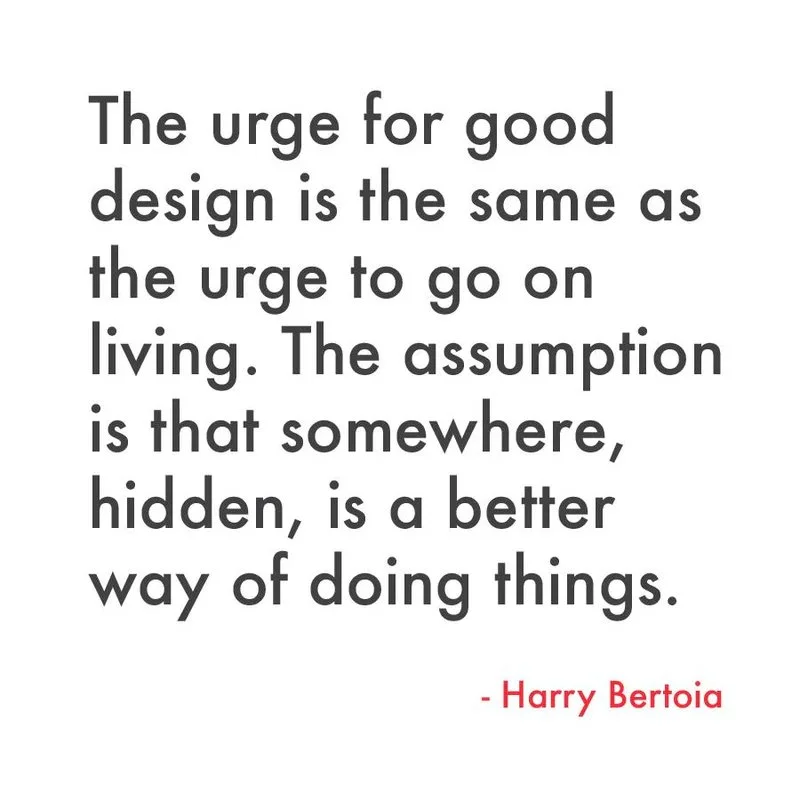Influential Designer: Harry Bertoia
Seemingly born with a natural instinct for design, Harry Bertoia was an expert jeweler, printmaker, furniture designer, sculptor, and philosopher. As Knoll historian Brian Lutz noted, “Bertoia’s paintings were better than his sculptures. And his sculptures were better than his furniture. And his furniture was absolutely brilliant.” Bertoia’s incredible work ethic, brilliant mind, and generous spirit have proved to immortalize him as one of the great modernist designers of all time.
Birth and Immigration to America
Harry Bertoia (born Arri Bertoia) was born on March 10, 1915, in the small village of San Lorenzo, Friuli, Italy. Bertoia was seemingly born with a natural instinct for design. At a young age, the brides in his small Italian town would ask him to design linen embroidery patterns for their wedding day – to which Bertoia expertly complied.
In 1930, at the age of 15, Harry moved to Detroit, Michigan to join his brother, Oreste, who had settled in America a few years before. Upon settling in America, Bertoia began to navigate life as an American. He first changed his name from Arri to Harry and then enrolled in Cleveland Elementary School to catch up in basics. Bertoia then went to Cass Technical High School – which was a public school that had a program for students who were talented in arts and sciences.
Education and Early Career
In 1936, Bertoia received a one-year scholarship to the School of the Detroit Society of Arts and Crafts where he studied painting and drawing. In the fall of 1937, through a second scholarship, Bertoia enrolled as a painting student at the Cranbrook Academy of Art in Bloomfield Hills, Michigan. It was at Cranbrook that Bertoia met Eliel Saarinen (father of Eero Saarinen) in 1939. Saarinen asked Bertoia to re-open a metalworking shop – but as WWII began, Bertoia was forced to concentrate on jewelry, which did not use much metal. Bertoia proved to be a successful metalworker and even designed the wedding rings for Ray Eames’ and his first wife, Ruth Bacon.
As his time at Cranbrook continued, Bertoia found that he also excelled in monotypes and after the demands of World War II dried up their metal supplies Harry spent his last year at Cranbrook as a graphics instructor.
After his time at Cranbrook, Bertoia left for California to join Charles Eames to work on their infamous plywood furniture series. Though Bertoia worked hard on and heavily contributed to the eventual success of the Eames chair, he received zero credit and therefore soon discontinued his collaboration with the Eames.
Collaboration with Knoll, Inc
In 1950, Bertoia moved to Pennsylvania to work with Hans and Florence Knoll. His experience with Knoll, Inc proved to be much better than his experience with the Eameses. Knoll, Inc. allowed Bertoia full autonomy as a designer while also giving him full credit for his work.
In 1952, Knoll introduced the Bertoia chair collection that featured the now infamous Diamond Chair and “Bird” Chair. Both of these chairs were engineering feats and were incredible representations of Bertoia’s ability to elevate everyday materials beyond their original intended use. Though he only designed one series of furniture for Knoll, Bertoia continued his collaboration with Knoll by designing sculptures and architectural installations for them.
Tonal Sculptures
Though Bertoia was an incredible furniture designer, it is perhaps his exploration and design of tonal sculptures with which his name most often associated. In 1960, Bertoia turned his focus, almost exclusively, to designing tonal sculptures along with his brother, Oreste. In 1962, the Bertoia brothers began holding concerts using a selection of their sculptures. They eventually recorded 11 albums and referred to these albums as “Sonambient” which was a term coined and registered by Bertoia to denote the audible and visual environment produced by the sculptures.
End of Life
Bertoia was always known for his incredible work ethic, but in 1976, upon learning of a cancer diagnosis, Bertoia work pace neared light speed. Bertoia worked hard to organize his life’s work – working through the thousands of pieces he had produced. In 1978, at the age of 63, Bertoia died peacefully in his home in Pennsylvania.


